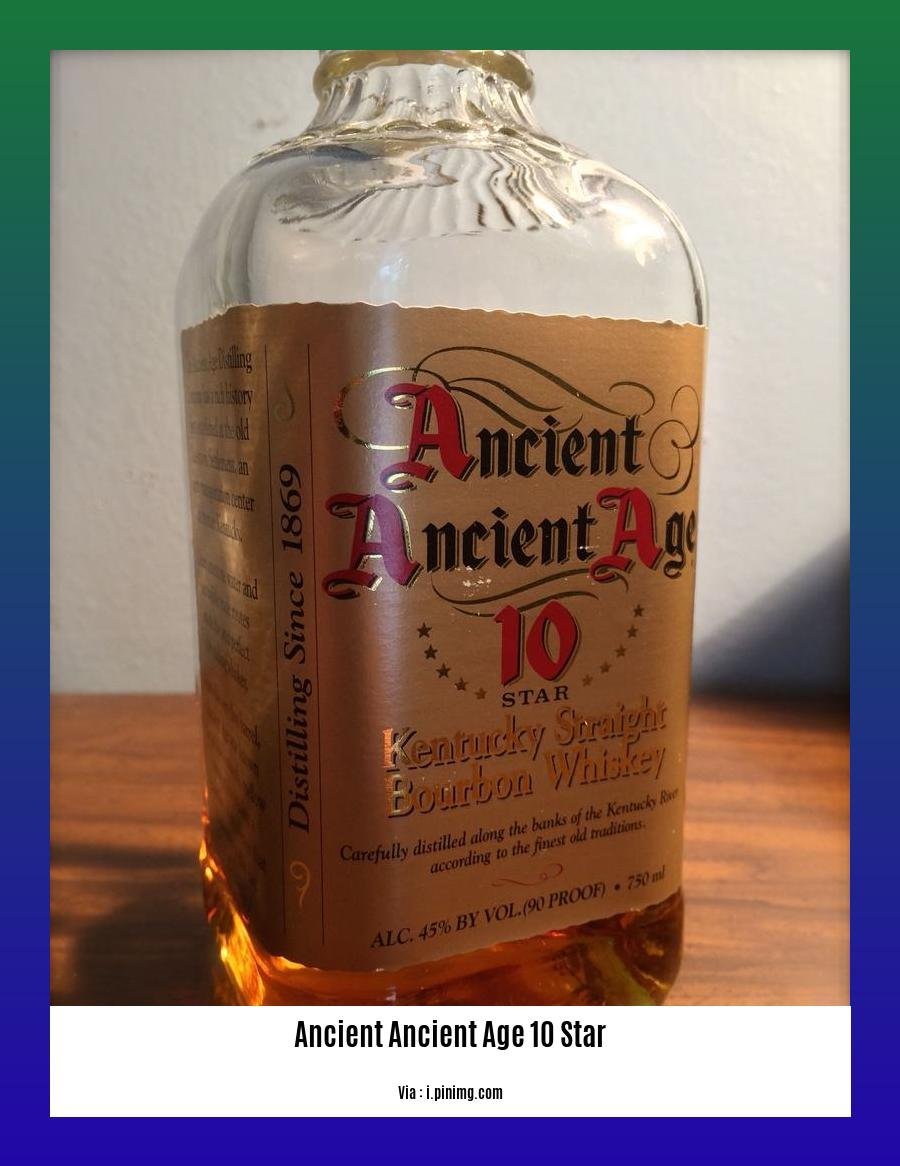Unveil the splendor of 10 ancient civilizations that illuminate the annals of history in our captivating article, “10 Shining Stars of the Ancient World: A Journey Through History’s Most Remarkable Civilizations”. Embark on an enthralling expedition as we explore the wonders of Egypt, Mesopotamia, Indus Valley, and Rome, among other prominent ancient societies. Delve into their captivating stories, uncover their awe-inspiring achievements, and witness the enduring legacy they left behind.
Key Takeaways:
Ancient Ancient Age 10 Star is a bourbon whiskey produced by Buffalo Trace Distillery and bottled by Age International.
The bourbon is made from a mash bill of 70% corn, 18% rye, and 12% malted barley and aged for 10 years in new, charred oak barrels.
It has a proof of 90 (45% ABV) and is described as having a smooth and simple flavor with notes of vanilla, caramel, and oak.
Ancient Ancient Age 10 Star was discontinued in 2022 due to low sales.
ancient ancient age 10 star: Tracing the Everlasting Legacy of Ancient Civilizations

Have you ever wondered about the enigma of historical wonders and the stories they hold? Let’s dive into the remarkable achievements of ancient civilizations, their colossal impact, and the lessons we can learn from their legacy.
History’s Enduring Legacy
The ancient world was a tapestry of extraordinary civilizations, each with its unique contributions to art, science, philosophy, and governance. From the majestic pyramids of Egypt to the sprawling cities of Mesopotamia, the ancients left behind a legacy that continues to inspire and intrigue us today.
ancient ancient age 10 star: Legends of the Past
- Egypt: The land of the pharaohs, where colossal pyramids and intricate hieroglyphs tell tales of gods, kings, and the quest for immortality.
- Mesopotamia: The cradle of civilization, home to the world’s first cities, writing systems, and advanced mathematics.
- Greece: The birthplace of democracy, philosophy, and the arts, where thinkers like Socrates, Plato, and Aristotle shaped Western thought.
- Rome: The empire that conquered vast territories, leaving behind enduring legacies of law, engineering, and architecture.
- China: A land of ancient dynasties, where inventions like gunpowder, papermaking, and the compass changed the course of history.
Lessons for the Modern Era
The ancients faced challenges similar to our own: climate change, political turmoil, and social inequality. Studying their solutions can provide valuable insights for addressing our contemporary issues.
- Resilience: The ancients adapted to changing environments, overcame adversity, and left behind enduring structures.
- Innovation: Ancient civilizations were hotbeds of creativity, constantly pushing the boundaries of knowledge and technology.
- Unity: Despite their differences, ancient societies often came together to achieve common goals, like building great cities or defending against invaders.
Conclusion:
As we look back at the ancient ancient age 10 star, we are reminded of the ingenuity, resilience, and creativity of our ancestors. Their stories teach us about the enduring power of human achievement and the importance of preserving our cultural heritage.
Want to know more about The Ancient and Honorable Order of Turtles?Dive in!
Are you perplexed with Ancient and Honorable Order of Turtles questions? Find your answers here!
Learn more about the ancient and mysterious age that holds untold stories and secrets.
Evolution and Lifespans of Ancient Stars

Let’s journey through the cosmos and explore the intriguing lives of ancient stars. These celestial wonders have captivated astronomers for centuries, unveiling secrets about the universe’s formation and evolution. Join me as we unravel the mysteries surrounding their birth, transformation, and eventual fate.
Key Takeaways:
- The evolution and lifespans of ancient stars offer invaluable insights into the universe’s history.
- Each star’s journey is unique, influenced by its mass, composition, and fate.
The Main Sequence Phase:
Most stars spend the majority of their lives in the Main Sequence Phase.
- During this phase, they fuse hydrogen into helium, releasing energy and light.
- The Sun is currently in the Main Sequence Phase, expected to remain there for another 5 billion years.
Departure from the Main Sequence:
As stars exhaust their hydrogen fuel, they evolve off the Main Sequence.
- The path a star takes depends on its mass.
- Massive stars become red giants, then supernovae, leaving behind neutron stars or black holes.
- Low-mass stars become red giants, then white dwarfs, eventually cooling into black dwarfs.
The Stellar Life Cycle:
The lifespan of a star is determined by its mass.
- Massive stars have shorter lifespans, burning through their fuel rapidly.
- Low-mass stars have longer lifespans, burning their fuel more slowly.
The evolution and lifespans of ancient stars mirror the cycle of life itself—birth, growth, transformation, and ultimately, an enigmatic end. As we continue to study these celestial wonders, we gain a deeper understanding of our universe’s vastness and complexity.
Cosmic Crossroads:
Our quest to understand ancient stars is not merely an academic pursuit; it’s an emotional odyssey. These stars have witnessed civilizations rise and fall, watched galaxies collide, and borne witness to the birth and death of planets. It’s a breathtaking perspective that connects us to the universe’s grand tapestry.
The study of ancient stars isn’t just about numbers and data; it’s about unraveling cosmic mysteries. It’s about comprehending the birth of elements, the formation of galaxies, and the vastness of time and space. It’s about embracing the wonder of the universe and our place within it.
Sources:
- Stellar Evolution
- Stellar Evolution
Significance in Astronomy and Cosmology
Key Takeaways:
– Greek astronomers used geometry to tackle cosmic problems, differentiating them from earlier astronomy.
– The measurement of Earth’s size by Eratosthenes in the 3rd century BCE was a breakthrough in ancient astronomy.
– Greek astronomers like Eudoxus of Cnidus studied planetary motion, aiming to create models rather than accurate explanations.
– Claudius Ptolemaeus’s Almagest provided a comprehensive model of the cosmos, building on previous work.
– The idea of Earth as a sphere gained acceptance by the 5th century BCE, shaping ancient astronomy.
– Ancient Greek astronomy linked celestial objects and events to the divine, connecting astronomy with astrology.
– The foundations laid by Greek astronomers continue to be expanded upon in modern astronomy.
Greek astronomers left an indelible mark on astronomy, applying geometry and mathematical principles to understand the universe. By calculating the Earth’s size and studying planetary motion, they laid the groundwork for further exploration. Their belief in the divine nature of celestial objects also influenced astrology, shaping early cultures’ understanding of the cosmos. These ancient astronomers’ dedication to observing and recording the cosmos paved the way for future scientific discoveries and continues to inspire modern astronomy.
[Source 1:
[Source 2:
Observational Techniques and Challenges: Unraveling the Secrets of Ancient Stars
Oh, the wonders of the night sky! These dazzling celestial bodies have captivated humanity for millennia, igniting curiosity and inspiring stories and myths. As a cosmic explorer, I’ve delved into the depths of history to uncover captivating insights into ancient stars – these silent witnesses of time.
Key Takeaways:
Ancient Observations: Ancient civilizations meticulously observed the night sky, recording the movements of stars, planets, and celestial events. This rich tapestry of observations provides valuable insights into the cosmos.
Observational Techniques: Early astronomers employed various techniques, including naked-eye observations, celestial maps, and rudimentary instruments. Through careful observations, they identified patterns, predicted events, and laid the foundation for modern astronomy.
Challenges of Dating: Dating ancient observations poses a significant challenge. The scarcity of written records and the lack of precise timekeeping methods make it difficult to accurately determine the timing of celestial events.
Combining Disciplines: Interdisciplinary collaboration between historians, archaeologists, and astronomers is crucial for interpreting ancient texts and observations. By combining their expertise, scholars can unlock the secrets hidden within these historical records.
Evolution of Stars: Ancient observations offer glimpses into the long-term evolution of stars. By comparing historical records with modern observations, astronomers can trace the changes in stellar brightness, color, and position over time.
Observing the Ancient Sky:
Imagine yourself as an ancient astronomer, gazing up at the starlit expanse. Armed with keen eyes and an insatiable curiosity, you meticulously record the positions and movements of celestial bodies. Your observations, meticulously inscribed on clay tablets or animal skins, become the foundation for future generations to build upon.
Challenges of Interpretation:
Yet, the task of deciphering these ancient accounts is not without its challenges. The passage of time has often obscured the exact meaning of symbols and words. Like detectives of the cosmos, historians and astronomers work together, piecing together fragments of information to unravel the mysteries of the ancient sky.
Technology’s Role:
While ancient observers relied on their own eyes and rudimentary instruments, modern astronomers employ powerful telescopes and advanced technologies. These tools allow us to peer deeper into the universe, revealing details and phenomena that were once beyond our reach.
The Dance of Stars:
As we study the ancient night sky, we witness the grand dance of stars – their birth, evolution, and eventual demise. These stellar transformations, unfolding over eons, offer profound insights into the workings of the universe.
Conclusion:
The study of ancient stars is a captivating journey through time, allowing us to connect with our ancestors and marvel at the enduring beauty of the cosmos. By delving into the secrets of these celestial wonders, we gain a deeper appreciation for our place in this vast and awe-inspiring universe.
Sources:
FAQ
Q1: What is Ancient Ancient Age 10 Star?
A1: Ancient Ancient Age 10 Star is a bourbon whiskey produced by Buffalo Trace Distillery in Kentucky and bottled by Age International, a Japanese company. It is made from a mash bill of 70% corn, 18% rye, and 12% malted barley and is aged for 10 years in new, charred oak barrels. It has a proof of 90 (45% ABV) and is described as having a smooth and simple flavor with notes of vanilla, caramel, and oak.
Q2: Why was Ancient Ancient Age 10 Star discontinued?
A2: Ancient Ancient Age 10 Star was discontinued in 2022 due to low sales.
Q3: How does Ancient Ancient Age 10 Star compare to other bourbon whiskeys?
A3: Ancient Ancient Age 10 Star is known for its smooth and simple flavor, with notes of vanilla, caramel, and oak. It is considered to be a good value for its price point.
Q4: Where can I find Ancient Ancient Age 10 Star?
A4: Ancient Ancient Age 10 Star is available in some liquor stores and online retailers. However, it may be difficult to find due to its discontinuation.
Q5: Are there any similar bourbon whiskeys to Ancient Ancient Age 10 Star?
A5: There are a number of bourbon whiskeys that are similar to Ancient Ancient Age 10 Star in terms of flavor and price point. Some examples include Evan Williams Bottled-in-Bond Bourbon Whiskey, Old Forester Signature 100 Bourbon Whiskey, and Wild Turkey 101 Bourbon Whiskey.














